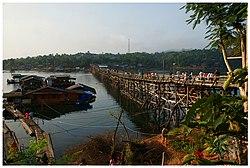Nong Lu
หนองลู | |
|---|---|
Tambon (sub-district) | |
 | |
| Coordinates: 15°09′02″N 98°27′09″E / 15.1505°N 98.4525°E | |
| Country | Thailand |
| Province | Kanchanaburi Province |
| District | Sangkhla Buri district |
| Area | |
• Total | 1,267 km2 (489 sq mi) |
| Population (2017)[2] | |
• Total | 26,524 |
| • Density | 21/km2 (54/sq mi) |
| Time zone | UTC+7 (ICT) |
Nong Lu (Thai: หนองลู) is a sub-district (tambon) of Sangkhla Buri district of Kanchanaburi province, Thailand. The name is Karen and refers to the palm used for roofing.[3] It is located near the border with Myanmar. Nong Lu covers the main town of the district, which is often known by the district's name as Sangkhlaburi (สังขละบุรี); the municipality (thesaban tambon) is officially known as Wangka (วังกะ).
Nong Lu is best known for the Uttamanusorn Bridge, the longest wooden bridge in Thailand, which connects the town of Sangkhla Buri to the Mon village of Ban Wangka. Other locations in the tambon are Wat Saam Prasob, a partially submerged temple, the Three Pagodas Pass which serves as the main pass into Myanmar, and Wat Wang Wiwekaram, a Buddhist temple built in 1953, and moved to Ban Wangka in 1985.
- ^ "ข้อมูลพื้นฐาน". Hnongloo (in Thai). Archived from the original on 10 November 2018. Retrieved 3 February 2022.
- ^ "รายงานสถิติจำนวนประชากรและบ้านประจำปี พ.ศ.2560". Department of Provincial Administration (in Thai). Retrieved 3 February 2022.
- ^ Cite error: The named reference
tambonwas invoked but never defined (see the help page).

